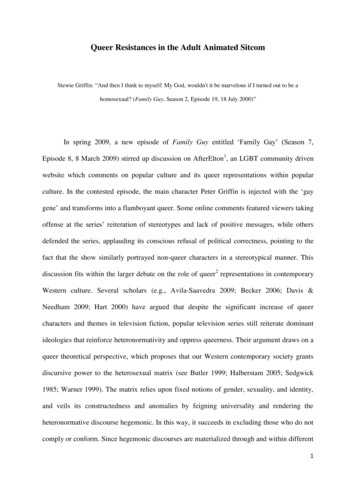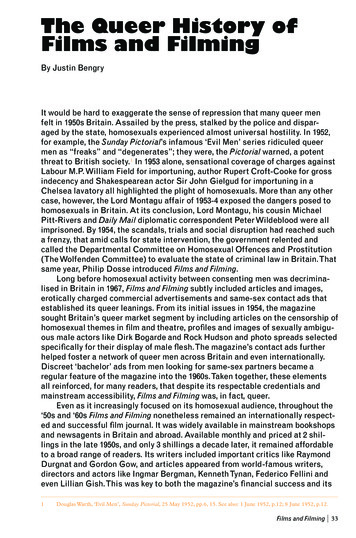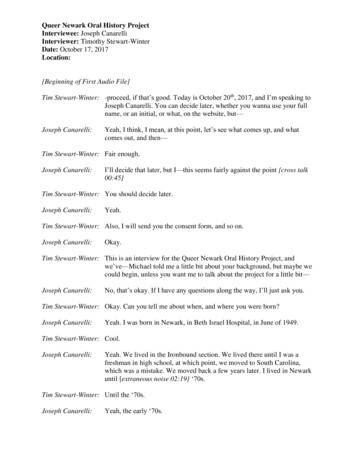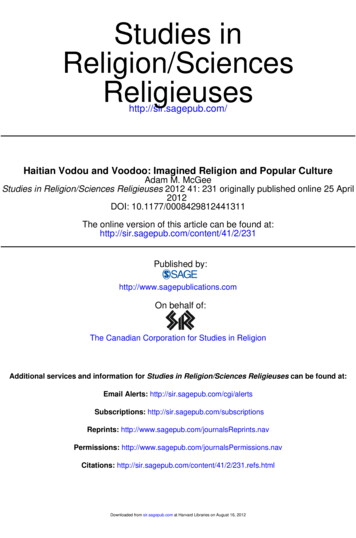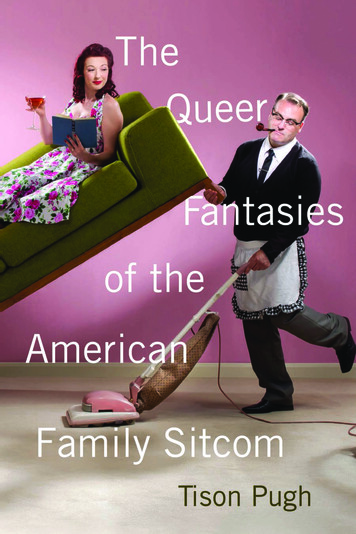
Transcription
The Queer Fantasies of theAmerican Family Sitcom
The Queer Fantasies of theAmerican Family SitcomTISON PUGHRutgers University PressNew Brunswick, Camden, and Newark, New Jersey, and London
Library of Congress Cataloging- in- Publication DataNames: Pugh, Tison, author.Title: The queer fantasies of the American family sitcom / Tison Pugh.Description: New Brunswick, NJ : Rutgers University Press, [2018] Includes bibliographicalreferences and index.Identifiers: LCCN 2017012061 (print) LCCN 2017027760 (ebook) ISBN 9780813591735(E- pub) ISBN 9780813591759 (Web PDF) ISBN 9780813591728 (hardback) ISBN9780813591711 (paperback)Subjects: LCSH: Situation comedies (Television programs)— United States— History andcriticism. Homosexuality and television. Homosexuality on television. Sex role on television. Television programs— Social aspects— United States.Classification: LCC PN1992.8.C66 (ebook) LCC PN1992.8.C66 P84 2018 (print) DDC791.45/617— dc23LC record available at https:// lccn .loc .gov/ 2017012061A British Cataloging- in- Publication record for this book is available from the British Library.Copyright 2018 by Tison PughAll rights reservedNo part of this book may be reproduced or utilized in any form or by any means, electronicor mechanical, or by any information storage and retrieval system, without written permission from the publisher. Please contact Rutgers University Press, 106 Somerset Street, NewBrunswick, NJ 08901. The only exception to this prohibition is “fair use” as defined by U.S.copyright law.The paper used in this publication meets the requirements of the American NationalStandard for Information Sciences— Permanence of Paper for Printed Library Materials,ANSI Z39.48– 1992.www .rutgersuniversitypress .orgManufactured in the United States of America
To my most beloved fellow Brady Bunch fans:Betsy Lefeaux BeairdMaggie Devlin LandryJennifer Jane LefeauxKellianne MollerBeth Ann Techow
ContentsIntroduction: TV’s Three Queer Fantasies1234561The Queer Times of Leave It to Beaver:Beaver’s Present, Ward’s Past, and June’s Future26Queer Innocence and Kitsch Nostalgiain The Brady Bunch51No Sex Please, We’re African American:The Cosby Show’s Queer Fear of Black Sexuality79Feminism, Homosexuality, and Blue- CollarPerversity in Roseanne107Allegory, Queer Authenticity, and MarketingTween Sexuality in Hannah Montana134Conservative Narratology, Queer Politics, and theHumor of Gay Stereotypes in Modern Family161Conclusion: Tolstoy Was Wrong; or, On the QueerReception of Television’s Happy Families190AcknowledgmentsList of Television ProgramsNotesWorks CitedIndex197199205227241vii
The Queer Fantasies of theAmerican Family Sitcom
IntroductionTV’s Three Queer FantasiesWhile starring in popular family sitcoms, Kirk Cameron of Growing Pains(1985– 92) and Angus T. Jones of Two and a Half Men (2003– 15) fulminatedagainst the lax morality depicted in their fictional households, biting thehands of producers who were very generously feeding them. Cameron skyrocketed to fame and teen idol status in his role as Mike Seaver yet complainedto the producers and writers about transgressions against his sense of Christian morality— such as a fantasy sequence implying that Mike had consummated his relationship with his girlfriend— stating that such a scene “crossesthe line in my conscience . . . and since I’m the guy who has to get up there anddo this in front of millions of people, I don’t want to do it.”1 Jones, while earning roughly 8 million annually, lambasted Two and a Half Men as “filth” andurged viewers not to watch it, stating, “It’s the number one comedy, but it’svery inappropriate and its themes are very inappropriate. I have to be this person I am not.”2 One would presume that these actors, notwithstanding theirdeeply held religious convictions, would understand that their occupationrequires them to play roles that might not accord with their personal views.The inherent ridiculousness of Jones’s proclamation— “I have to be this person that I am not”— is true of every actor in every part, and his assumption ofthe role of teen regulator of American morality smacks of righteousness ratherthan rightness.But while it is easy to dismiss Cameron’s and Jones’s diatribes for their sincere yet grandiose moralizing, might one concede that, on a historical andnarratological level, they have a point to argue about the nature of the familysitcom in the United States and its trajectory from the 1950s to today, as well as1
2 The Queer Fantasies of the American Family Sitcomabout the fluid protocols of the networks’ programming in relationship to thechimerical concept of “family- friendly programming”? In his autobiography,Cameron argues that “a TV series has an unspoken agreement to be what ithas been from the beginning. A sitcom shouldn’t become a drama. Nobodywants to see a homicide investigation on Mr. Belvedere.”3 In some ways, Cameron’s discomfort with his program’s escalating treatments of sexuality reflectshis understanding of an inherent contradiction in the generic structure of thefamily sitcom, as it faces the challenge of creating fare appropriate for all familymembers, no matter their ages. His argument about the suitability of certainstory lines for television programs— that narrative paradigms construct protocols for writers and producers, as well as expectations for viewers— is a reasonable assessment of the utility of aesthetic genres. These issues of genre andinterpretation foist vexing pressures on family sitcoms because they, in manyways, are expected to capture for viewers a nostalgic, ostensibly timeless viewof American domestic life rather than its shifting realities.In their laments against television’s lax morality, Cameron and Jones tacitly advocate the three fantasies that underpin this study— the genre of thefamily sitcom, the long- standing and historically recurrent marketing concept of family- friendly programming, and children themselves— while overlooking their inherently queer potential. To discern queer potential in thesetelevisual texts is to argue against their historical and generic facade of smiling, feckless, American normativity. In brief, queerness as a critical concept fractures cultural constructions of gendered and erotic normativity,dismantling rigid binary codes of licit and illicit desires and identities. Queerrefers to contested sexual and gender identities but extends further to includeidentities that challenge regimes of normativity. More so, queerness exposeshow deeply heteronormative narrative frameworks, such as that of the familysitcom, are structurally incapable of suturing over their aporias and contradictions, such that their surface normativity cannot withstand the steady erosionof their symptomatic queerness. David Eng, Jack Halberstam, and José Esteban Muñoz state that queerness and queer theory “challenge the normalizingmechanisms of state power to name its sexual subjects: male or female, marriedor single, heterosexual or homosexual, natural or perverse.”4 In this light, queertheory serves as a preferred tool for querying any genre or social practice thatvalorizes normality, as family sitcoms, virtually by their existence, attempt toaccomplish— or, more potently, have been conscripted to accomplish in theirreception. Such an approach does not simply cement a long- standing binarybetween the queer and the normative but instead depicts their radical intertwining, such that the normative cannot, in the final analysis, obscure thequeer at its heart.To describe the disparate entities of a televisual narrative structure, anadvertising ploy, and young humans as queer fantasies does not deny their
Introduction 3effect or reduce them to gossamer ephemeralities, of course, yet doing so highlights the ways in which they serve, and concomitantly subvert, ideologicalobjectives outside themselves. Individually and collectively, domestic sitcoms, family- friendly programming, and children act as discursive conceptsthrough which television narratives are staged, marketed, and consumed butalso through which cultural battles are waged over the fate of America’s moralcondition— primarily to bemoan a coarsening of the entertainment industrybut, through other eyes, to celebrate increasingly candid depictions of sexuality as an integral part of the human experience. So discussions of familysitcoms often touch on issues of morality and pseudotheological attempts todefine what American families should both be and see— as Cameron, Jones,and cultural commentators of their ilk demonstrate.As is readily apparent by even a cursory overview of the featured programsof this volume— Leave It to Beaver (1957– 63), The Brady Bunch (1969– 74), TheCosby Show (1984– 92), Roseanne (1988– 97), Hannah Montana (2006– 11),and Modern Family (2009– )— family sitcoms from the 1950s to the 2010srecord America’s changing sexual and social norms, but it is not my objectiveto chart the history of sexual depictions— the first married couple to share abed, the first gay kiss, the first teen character to lose his or her virginity. Instead,this study examines how the families of domestic sitcoms simultaneously resistand display sexuality’s cultural shifts transpiring throughout the United Statesat various historical moments, for the purported innocence of children necessitates complex and conflicting strategies for addressing the eroticism ostensibly shunted to these programs’ margins. Neither narrating a downward spiralinto vulgarity nor applauding increasingly graphic depictions of sexuality, TheQueer Fantasies of the American Family Sitcom instead analyzes the ways inwhich children, families, and sexualities interact in relation to a host of othercultural issues, for sexuality serves as a preferred, if obscured, site of ideological power. As Michel Foucault so powerfully observes of sexuality’s meaning:“Sexuality must not be thought of as a kind of natural given which power triesto hold in check, or as an obscure domain which knowledge tries gradually touncover. It is the name that can be given to a historical construct: not a furtivereality that is difficult to grasp, but a great surface network in which the stimulation of bodies, the intensification of pleasures, the incitement to discourse,the formation of special knowledges, the strengthening of controls and resistances, are linked to one another, in accordance with a few major strategiesof knowledge and power.”5 Of particular concern to children’s genres, whichinclude family sitcoms within their purview, Foucault notes the “pedagogization of children’s sex” and the “psychiatrization of perverse pleasure” as keytactics in the ideological construction of sex. Early family sitcoms (mostly)refrain from addressing sexuality and “perverse” pleasures, yet what theyattempt to hide inevitably bleeds through into story lines otherwise cleansed
4 The Queer Fantasies of the American Family Sitcomof such fare. And so they must: a foundational irony of family sitcoms emergesfrom their tendency to camouflage or otherwise cloak sex, thus overlookingthe foundational role of sex in building the families depicted onscreen.Such narrative tensions result in queerness, in the disruptions of genderedand (hetero)sexual normativity ostensibly encoded in these TV narratives thatinvariably cannot prevent fissures from subverting their surface presentation ofthe American family in the throes of domestic bliss. Queerness, as AlexanderDoty argues in his landmark study of gay representations in popular media,serves “to mark a flexible space for the expression of all aspects of non- (anti- ,contra- ) straight cultural production and reception. As such, this cultural‘queer space’ recognizes the possibility that various and fluctuating queer positions might be occupied whenever anyone produces or responds to culture.”6Various studies have traced the history of gay portrayals on television from virtual absence to a vibrant presence, as they have also noticed the ambivalenceof many such depictions.7 As Lynne Joyrich cautions, “It’s the ambivalence,though, of how queerness can be both the electrical spark and the groundingagainst any possible shock that remains the paradox and the problem— indeed,I’d argue, the problematic— for queer television studies.”8 This book contributes to this ongoing discussion by exploring how the fantasies of genre, of marketing, and of children can never fully cloak the queerness lurking within theplucky families designed for American viewers’ comic delight. Queer readingsof family sitcoms demolish myths of yesteryear, demonstrating the illusion ofAmerican sexual innocence in television’s early programs and its lasting consequences in the nation’s self- construction, as they also allow fresh insights intothe ways in which more recent programs negotiate new visions of sexualitywhile remaining indebted to previous narrative traditions and long- standinggeneric conventions. Simply put, queer readings of America’s domestic sitcomsradically unsettle the nation’s simplistic vision of itself, revealing both a deepervision of its families and of a television genre overwhelmingly dismissed asfrivolous fare.The Queer Fantasy of the Family SitcomWithin the world of narrative analysis, genres stand as trivial yet essential constructions: trivial, because they divulge so little; essential, because they establish a framework for understanding and digesting a cultural work. As JasonMittell explains of television genres, “Genre definitions are no more naturalthan the texts that they seem to categorize. Genres are cultural products, constituted by media practices and subject to ongoing change and redefinition.”9For example, to label a television show a mystery is to give only the baresthints of its contents or its aesthetic quality, for the form ranges from modern classics, such as Helen Mirren’s gutsy performances in the Prime Suspect
Introduction 5series (recurring from 1991 to 2006) to kitschy flops, such as Loni Anderson’sand Lynda Carter’s stars fading in the short- lived Partners in Crime (1984); itincludes as well the subgenre of procedurals (e.g., Law & Order [1990– 2010],CSI: Crime Scene Investigation [2000– 2015]), in which plot takes precedenceover character development and emotional depth. In this light, genres represent little more than collective fantasies, a helpful yet inconsequential attemptto organize art into conceptual categories— categories that the creators of theseworks, according to their unique visions, then dismantle or, more optimistically, reconstruct. Within the television economy, genres emerge through thecomplex interactions of creative talent, producers, and audiences, with eachexerting their influence on which programs are created, aired, and renewed,both in regard to individual shows and the genres of which they serve as constituent elements.Of the various television genres, the situation comedy towers as a resilientlypopular form, reborn in successive generations and capturing various aspectsof its zeitgeist. Richard Butsch observes that the “situation comedy is builtaround a humorous ‘situation’ in which tension develops and is resolved during the half hour. In episode after episode the situation is re- created.”10 Manysitcoms succinctly establish their foundational comic premise in their titles:lost on a tropical paradise in Gilligan’s Island (1964– 67), or the continualdelay of answering the apparently simple question of How I Met Your Mother(2005– 14). Even sitcoms named for their eponymous protagonist disclosetheir situational plotlines once audiences understand his or her identity: awhite couple adopting a young African American child in Webster (1983– 89)or the neurotic nothingness of Seinfeld (1989– 98). Moreover, sitcoms typicallyadhere to formulaic plots that do not advance their foundational premises.As Paul Attallah explains: “It is a narrative necessity of situation comedy thatthe ‘situation’ must remain unchanged. If the program is to be repeated weekafter week, the characters and their mode of interaction must not be allowedto evolve. Were they to acquire experience, then evolution would occur andthe show would not continue.”11 Attallah’s point is clearly evident in the vastmajority of sitcoms, for most episodes of a series can stand alone without thescaffolding of past narratives. The genre’s popularity is matched by its lucrative payoffs, for, as Lawrence Mintz notes, financial incentives abound owingto the fact that the sitcom “reigns supreme in the syndication market and asan exportable commodity”— which further explains its resiliency despite thevarious programming fads over the decades since television’s rise.12 If a sitcomcan remain in production long enough to be distributed in syndication— typically, for five seasons, or approximately one hundred episodes— a financialbonanza awaits.Under the wider rubric of situation comedies, the subheading of family, ordomestic, sitcoms stands as one of its most durable, even beloved, forms. Lynn
6 The Queer Fantasies of the American Family SitcomSpigel states that the genre’s traditional parameters include “a suburban home,character relationships based on family ties, a setting filled with middle- classluxuries, a story that emphasizes everyday complications, and a narrative structure based on conflicts that resolve in thirty minutes.”13 Horace Newcombdistinguishes between situation comedies and domestic comedies, with thelatter taking as their domain the daily activities of a given family, which, ashe argues, results in programs with “more warmth and a deeper sense ofhumanity” than standard sitcoms.14 The names of many of TV’s families resonate with an appeal both nostalgic and iconic: the Nelsons of The Adventures of Ozzie and Harriet (1952– 66), the Ricardos of I Love Lucy (1951– 57),the Cunninghams of Happy Days (1974– 84), as well as the six primary clansexamined in this monograph: the Cleavers of Leave It to Beaver, the Bradys ofThe Brady Bunch, the Huxtables of The Cosby Show, the Conners of Roseanne,the Stewarts of Hannah Montana, and the Pritchetts, Tucker- Pritchetts, andDunphys of Modern Family. These fictional families have influenced countlessviewers’ perception of American domesticity, even when filtered through suchlenses as irony, nostalgia, or incredulity.The narrative structure of family sitcoms favors pat conclusions for theirplots, and most of these programs end with a touch of moralizing, summarizing the lessons learned from the transgression against the family’s rules. Manystory lines involve only a minimal disruption of the family’s unity, whichGeorge Burns suggests sardonically in a moment of metadiscourse in his GeorgeBurns and Gracie Allen Show (1950– 58): “We try to strike a happy medium.We have more plot than a variety show, and not as much as a wrestling match”(“Chapter 3”).15 Whatever the extent of the transgression, all is forgiven bystory’s end, as is evident in— to take one example out of the thousands of narratives constituting sitcom history— the “Body Damage” episode of FamilyMatters (1989– 98). Rachel (Telma Hopkins) damages her brother- in- law’s car,and the family conspires to keep it a secret from him. When Carl (ReginaldVelJohnson) learns the truth, he is more upset about the secret than the car:“But guys, remember, we’re a family. Your problems are my problems. But Ican’t do anything about them unless you let me know what they are, okay?”His wife, Harriette ( JoMarie Payton), agrees, speaking for herself and the restof the family: “Right, baby. From now on, this family sticks together.” DavidMarc describes the plotlines of family sitcoms as “illustrat[ing], in practical everyday subphilosophic terms, the tangible rewards of faith and trustin the family,”16 so even in family sitcoms that flagrantly rewrite the codes ofdomestic life into gleeful odes to dysfunctionality, the family unit remainssacrosanct: Al and Peg Bundy of Married with Children (1987– 97), despiteapparently loathing each other, could never divorce, for doing so would severthe program’s foundational premise of familyhood.
Introduction 7But defining the apparently simple genre of the family sitcom conjures afoundational hermeneutic conundrum, for what configuration of individualsand consanguinity constitutes a family? The American family persists as avibrantly amorphous entity, one that shifts in accordance with the prevailingzeitgeist, and further along these lines, prominent subgenres of family sitcomsrewrite the significance of children to the family unit or construct childhoodaccording to varying parameters. For instance, All in the Family (1971– 79) features bigoted antihero Archie Bunker (Carroll O’Connor) and his wife, Edith( Jean Stapleton), in its lead roles, along with their daughter, Gloria (SallyStruthers), and son- in- law, Mike “Meathead” Stivic (Rob Reiner). WhileGloria is indeed Archie and Edith’s child, she is hardly one in the sense of aninnocent naïf; on the contrary, she resists her father’s prejudices on numerousoccasions and denounces him accordingly: “You are so sick,” she asserts afterone of his antiethnic rants (“The Joys of Sex”). In complementary contrast,Everybody Loves Raymond (1996– 2005) reverses the standard intergenerational dynamic of most family sitcoms, with its plotlines addressing the rockyrelationship of Ray (Ray Romano) and Debra Barone (Patricia Heaton) withRay’s overbearing parents, Frank (Peter Boyle) and Marie (Doris Roberts).Thus, the variability of children and their ages affects— sometimes multiplying, sometimes restricting— the register, themes, and audiences available to aparticular sitcom.As this brief overview of family sitcoms and their shifting parametersattests, this genre is amorphous, as are all genres, and it is in the end, I think,unhelpful to construct a definition of the term that unnecessarily delimits itin light of its protean variations— one, for example, that would embrace TheBrady Bunch for its focus on six young children but omit All in the Familybecause of Gloria’s early adulthood. Rather, the variability of familial relationships for each of these programs requires viewers to examine how a particularconstruction of kinship complements its narrative investments in other issuesand the ways in which queer themes seep into a genre overarchingly conveyingthe fundamental sexual normativity of its members. For in so many instances,any promise of seamless heteronormativity is inevitably complicated, ifnot undone, as a program broaches topics it otherwise promises to eschewthrough its generic affiliation, thus rendering queer the very concept of thefamily- sitcom genre. At the same time, for the purposes of interpretive clarity,this volume focuses on programs that include young teen and preteen childrenas primary cast members, for these programs stake their appeal to viewers ofall ages— even if their narratives are sometimes deemed too provocative forthe fantasy of family- friendly programming. Television’s funny families withyoung children must tacitly address the issue of how to depict sexuality in amanner that will not alienate real- life parents tuning in to watch a program
8 The Queer Fantasies of the American Family Sitcomwith their kids, so the marketing concept of family- friendly programmingattempts to assuage parents’ concerns about television content through thisultimately meaningless designation.The Queer Fantasy of Family- Friendly Programming“You know, FOX turned into a hardcore sex channel so gradually I didn’teven notice,” sighs Marge Simpson in The Simpsons (“Lisa’s Wedding”), in asatiric jab at network television’s increasingly graphic depictions of sexualityover the years. Marge’s words exaggerate yet echo recurring criticisms of television’s shifting mores, particularly in relation to the chimerical concept offamily- friendly programming. From television’s early days, when the majorityof families who owned a set owned only one and gathered together to watchit, domestic sitcoms were built on the foundational premise of appealing tothe various members of their audiences, with the assumption that each member of a viewing family would identify with his or her corresponding role inthese narrative families. As Lawrence Laurent notes in his classic 1956 study,family sitcoms enhance their commercial value through their multiple pointsof audience identification: “In some ways, commercial sponsorship is directlyresponsible for the kinds of programs which are seen on television. If thesponsor is trying to win 100 percent acceptance of his product, he is likely toprefer a program which will appeal to 100 percent of the audience. This factaccounts, in large part, for the plethora of ‘family situation comedies’ whichfill the TV schedules.”17 Early television advertisers also saw the benefit ofappealing directly to child viewers, as Vance Packard charges in his 1957 antipropaganda classic The Hidden Persuaders, in which he quotes a contemporaryadvertiser to reveal the industry’s unscrupulous methods and pecuniary aims:“Think of what it can mean to your firm in profits if you can condition a million or ten million children who will grow up into adults trained to buy yourproduct as soldiers are trained to advance when they hear the trigger words‘forward march.’”18 In sum, advertisers have long relied on family- friendly programming, little more than a marketing ploy based on an ecumenical appealto various demographics, as they urge audiences to purchase their wares. Thisstrategy bears the side- effect that viewers will inevitably compare themselvesand their ideal vision of the American family to the images seen onscreen,with these sitcom families validating certain forms of kinship and overlooking others. Such a simplistic assessment cannot account for the multiple andcontradictory viewing positions any given individual may stake in relation toa program, nor did most early television families recognize the diversity of theAmerican family in relation to race, gender, and other identities excluded bythe normative assumption of suburban whiteness. Nonetheless, this marketing foundation of universality imbues domestic sitcoms with accompanying
Introduction 9values and appeals, thus virtually assuring their queer collapse under theseinherent contradictions.Recurring controversies over the chimerical concept of the “family hour”showcase the queer and hazy parameters of any real commitment to family- friendly programming on the part of the legacy networks and cable channels.A staunch defender of this fantasy, television critic Thomas Johnson proposesthat “shows airing in that hour should not merely entertain children, but begood for them; they should reinforce traditional values, not subvert them,”citing Little House on the Prairie (1974– 83), Happy Days, The Cosby Show,and Full House (1987– 95) as examples of appropriate family- friendly fare.19 Afamily hour was unnecessary during television’s early years when the networkscensored themselves to the extent that on I Love Lucy, Lucy (Lucille Ball)and Ricky Ricardo (Desi Arnaz) avoid the word “pregnant”— preferringinstead the euphemism “expecting.” By the 1970s, however, concern hadmounted increasingly over programs’ candid depictions of controversialtopics, including racism, violence, women’s reproductive rights, and homosexuality. The 1971 report “Television and Growing Up: The Impact of Televised Violence,” submitted to Surgeon General Jesse Steinfeld, concludes that“The Department of Health, Education and Welfare would do well to considerincreased involvement in this field, not just in relation to the possibly harmful effects of television, but also to develop the experience and professionalrelationships needed to consider and stimulate television’s health- promotingpossibilities.”20 The federal government, identifying a moral scourge on thetelevision screens of the nation’s families, charged itself with the improvementof the American mind.Seeing the handwriting on the wall, and responding to additional pressurefrom Congress and the Federal Communications Commission, the networksembraced and codified family- friendly protocols in 1975, agreeing that the firsthour of prime- time scheduling would consist of shows appropriate for all ages.Arthur R. Taylor of CBS Entertainment endorsed the “Family Hour” plan,which, as Richard Blake attests, “was adopted into the Code of the NationalAssociation of Broadcasters in April, 1975, and became policy at the start ofthe 1975– 76 season.”21 Unsurprisingly, the family- hour policy proved exceedingly unpopular among the creative forces behind network television. NormanLear, producer of All in the Family, Maude (1972– 78), Mary Hartman, MaryHartman (1976– 77), and other popular programs, asked Robert D. Wood,president of CBS Television (1969– 76), to clarify its parameters but receivedonly equivocations and so replied with cheeky exasperation, “Well, how canyou think of moving [All in the Family] out of the Family Hour unless youknow what it is? . . . Is there something you can read to me so I’ll know whatit is you want me to conform to?”22 Additional creative voices expressing outrage over the tyranny of the family hour included George Schlatter, executive
10 The Queer Fantasies of the American Family Sitcomproducer of Rowan and Martin’s Laugh- In (1967– 73) and Cher (1975– 76),who tersely jibed, “The family hour sucks,” and Paul Junger Witt, executiveproducer of The Partridge Family (1970– 74) and Soap (1977– 81), who agreedthat it was “an outrageous pain in the ass.”23 Rebelling against the restrictionsit imposed, television programs of the era employed the family hour as fodder for sarcastic humor, such as in One Day at a Time (1975– 84), when petulant daughter Julie (Mackenzie Phillips) snipes at her mother, Ann (BonnieFranklin), for treat
vii Contents Introduction: TV's Three Queer Fantasies 1 1 The Queer Times of Leave It to Beaver : Beaver's Present, Ward's Past, and June's Future 26 2 Queer Innocence and Kitsch Nostalgia in The Brady Bunch 51 3 No Sex Please, We're African American: The Cosby Show's Queer Fear of Black Sexuality 79 4 Feminism, Homosexuality, and Blue- Collar



